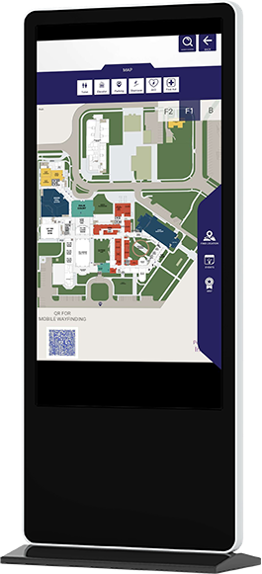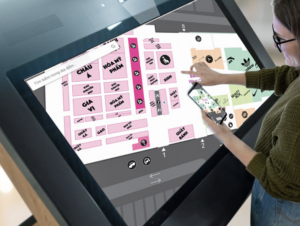You’re at the airport to catch a flight. You pay for parking, check in and check your bag, locate your gate in the terminal, and get an update on the plane’s ETA. At every step of the way, there’s a kiosk ready to provide the service or information you need.

And transportation isn’t the only industry being transformed by the use of kiosks. It’s been fascinating to see them become commonplace in just about every aspect of our daily lives. We use ATMs to get money; those are referred to as financial kiosks. Touchscreen-based kiosks allow us to place our orders at restaurants. We buy our groceries at self-checkout kiosk stations. Interactive directories help us find a doctor’s office in a healthcare building or a hotel meeting space at an event.
It’s no surprise, then, that the self-service kiosk market is projected to see $42.66 billion in global revenue by 2028, according to Grandview Research. Accommodating that growth requires innovation, and we will continue to see exciting advancements that enhance kiosks’ functionality and capabilities, making them even more essential to modern life.

For anyone who is thinking about implementing kiosks at their business, or upgrading the ones they already have, it’s crucial to keep pace with the latest advancements to maximize their investment and provide an optimal user experience. Here are some of the key areas to focus on:
Content Matters
Kiosks are effective delivery systems for disseminating all types of information, from emergency alerts to tourist tips. But you lose that effectiveness if your information lacks clarity or critical details.
I particularly see this happen when it comes to wayfinding. Imagine trying to navigate a vast convention center to find the event you want to attend. You locate a map on the center’s kiosk, but it only gives you the vaguest idea of where your event takes place, let alone the best way to get there from your current location.

Current kiosk technology, however, can use downloadable QR codes to provide accurate, personalized directions you follow on your smartphone so you don’t get lost. Or picture a wayfinding map in 3D. As display hardware and software technologies keep evolving, we will see an expanded use of 3D kiosk screens.
And this won’t be limited to informational or self-service kiosks: Companies are already developing entertainment kiosks that integrate 3D to offer a better user experience. This is an area where we will see thrilling progress that can reinvent how we interact with kiosks. The best opportunity to keep up with this progress is at Display Week, which showcases the latest advances in screen technology from around the world.
Explore New Revenue Streams
Initially, purchasing and installing a kiosk system calls for significant expenditures, plus the added expense of ongoing upkeep and maintenance. However, those costs can be offset with new revenue-generating opportunities.
Ad sales are a prime example. A mall kiosk, for instance, offers multiple marketing possibilities: static ads promoting individual stores, movie trailers for coming attractions at the multiplex or interactive product ads where users can zoom in to see certain features using touchscreen technology (then use a QR code to get a coupon for said product).
Retail kiosks are also ideal for upselling services or products. Maybe it’s a buy one, get one free offer, or a larger-sized beverage for just $1 more. And while the customer is there, a kiosk can offer enrollment in a loyalty or rewards program with just a few taps on the touchscreen.
The possibilities aren’t limited to what’s on the screen. Kiosks collect valuable user data that can drive sales and marketing strategies. With the right software, kiosk owners can track the services and products that people are (or aren’t) engaging with and adjust accordingly to align with their preferences.
Ride the Technology Wave
It’s amazing to see how far kiosk display technology has come over the years. LCD (liquid crystal display)has been the most common display technology for kiosks. And ePaper is used in kiosks that are outdoors or in applications where the content does not change much; this technology consumes zero power when the content is static. But in recent years, newer technologies have been developed that hold great potential:
OLED (Organic Light-Emitting Diode)
High contrast, vivid color saturation, and incredible image quality — these are the hallmarks of OLED technology. We’ve seen OLED at work in cell phones, tablets, and TVs, and the technology could move into kiosks as well, but it’s not quite there yet. It adapts well to most screen sizes, has touchscreen and transparent capabilities, and its thinner, flexible formats in the future might maintain an image on curved or foldable screens.
MiniLED
MiniLED backlights for LCD kiosks allow LCD to compete better with OLED in terms of visual quality. I see this happening relatively soon since we are combining two relatively mature technologies that are also low cost.
MicroLED
If there’s one emerging technology to watch, it’s this one. MicroLED promises to combine the best attributes of MiniLED and OLED. While kiosks likely won’t be MicroLED’s first application, as marketers we are also dreamers, so I envision a MicroLED kiosk in the distant future.
Keep Up with Kiosk Technology
The future of kiosks is bright, and we’ll see all these innovations in action at Display Week 2024. Join me May 12-17 in San Jose.

Sri Peruvemba is CEO of Marketer International Inc. and a volunteer at SID. Peruvemba was previously Chief Marketing Officer for E Ink, where he played a major role in transforming the startup to a $1B+ global company. Peruvemba won SID’s 2022 Lewis and Beatrice Winner Award. Peruvemba has also held senior level positions at Sharp Corp, Cambrios, Novasentis, TFS Inc., Planar Systems, and Suntronic Technology. Based in Silicon Valley, Peruvemba advises high tech firms globally as well as serves on the boards of Edgehog, Omniply, SmartKem, Visionect and WiSA Technologies. He has BS and MBA degrees and a post-graduate diploma in management. Peruvemba is also a right arm off-spinner for a Cricket team he co-founded in Silicon Valley.

